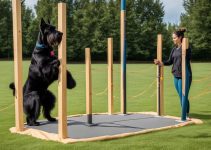Training a Pekingese can be quite a challenge due to their independent nature. However, with the right approach and techniques, you can make the training process easier and more enjoyable for both you and your furry friend.
In this article, I will share easy tips and tricks for Pekingese training, whether it’s obedience training, behavior training, or even training a new puppy. By following these tips, you can strengthen the bond with your Pekingese and teach them new tricks.
Discover Pekingese Training
- Training a Pekingese requires patience and consistency.
- Use positive reinforcement techniques, such as rewards and praise, to motivate your Pekingese.
- Start training early and set realistic expectations for your Pekingese.
- Basic training tips such as leash training and crate training are essential for a well-behaved Pekingese.
- Consider seeking professional guidance or enrolling in training classes for more specialized training.
The Importance of Rewards in Pekingese Training
Rewards are a vital component of effective Pekingese training. By using positive reinforcement techniques, such as food rewards and praise, you can motivate your Pekingese to learn new behaviors and strengthen their training foundation. Rewards serve as powerful incentives, encouraging your Pekingese to actively participate in training sessions and reinforcing positive behaviors.
Positive reinforcement training involves rewarding desired behaviors to encourage their repetition. This training method relies on the principle that dogs are more likely to engage in behaviors that result in pleasant outcomes. By associating rewards with specific commands or actions, you can shape your Pekingese’s behavior in a positive and supportive manner.
When implementing rewards in Pekingese training, it’s essential to choose incentives that truly motivate your furry companion. High-value treats like small pieces of chicken or cheese can be effective tools when teaching new commands or tricks. Praise and petting are also valuable rewards, as they provide emotional reinforcement and strengthen the bond between you and your Pekingese.
To effectively utilize rewards, consider the following tips:
- Timing is crucial: Deliver rewards immediately following the desired behavior to effectively associate the behavior with the reward.
- Consistency is key: Ensure that rewards are consistently given for the desired behaviors to reinforce the training process. This consistency helps your Pekingese understand the cause and effect relationship between their actions and the rewards they receive.
- Vary the rewards: Mix up the types of rewards you use during training sessions to keep your Pekingese engaged and excited about the training process.
- Gradually reduce the use of treats: Slowly transition from using food rewards to relying solely on praise and petting as your Pekingese becomes more proficient in their training. This helps them generalize the learned behaviors and respond to verbal cues.
By incorporating rewards into your Pekingese’s training routine, you can create a positive learning environment and motivate your furry friend to excel. Remember, consistency and positive reinforcement are key to successful and enjoyable Pekingese training.
Basic Training Tips for Pekingese
Training your Pekingese is an essential part of ensuring their well-being and happiness. By implementing some basic training techniques, you can establish a strong foundation for your Pekingese’s development. In this section, I will share valuable tips on leash training, crate training, and available training classes and resources.
Leash Training
Leash training is crucial for ensuring your Pekingese’s safety during walks and outdoor activities. Start by introducing your Pekingese to the leash gradually. Allow them to sniff and explore it before attaching it to their collar or harness. Begin with short, controlled walks in familiar surroundings. Use treats and positive reinforcement to encourage good behavior when your Pekingese walks calmly beside you. Remember to be patient and consistent throughout the process.
Crate Training
Crate training provides a safe and cozy space for your Pekingese while helping with house training and preventing destructive behaviors. Introduce the crate as a positive and comfortable environment by placing their bed and toys inside. Start with short periods of confinement, gradually increasing the duration as your Pekingese becomes accustomed to the crate. Be sure to make it a positive experience by offering treats, praise, and rewards when your Pekingese enters the crate willingly.
Training Classes and Resources
Enrolling your Pekingese in training classes can be highly beneficial for their development. These classes provide structured learning opportunities and socialization with other dogs. Look for reputable training classes specifically catering to Pekingese or small breed dogs. Additionally, there are various online resources and training guides available to assist you in the training process. These resources provide step-by-step instructions, tips, and troubleshooting advice tailored to the unique needs of Pekingese training.
By incorporating these basic training tips into your Pekingese’s routine, you can create a happy and well-behaved companion. Remember to be patient, consistent, and utilize positive reinforcement techniques. With time and dedication, your Pekingese will thrive in their training journey.

Secrets to Pekingese Obedience Training
When it comes to training your Pekingese, unlocking the secrets to obedience training can make all the difference. In this section, I’ll share insider tips and techniques from expert trainers and experienced Pekingese owners that will help you achieve success in training your furry companion.
Start Early and Be Consistent
One of the key secrets to Pekingese obedience training is starting early and being consistent. Pekingeses are intelligent dogs, but they can also be stubborn. By beginning their training at a young age, you can establish good habits and reinforce positive behaviors. Consistency is key in any training program, so make sure to set a regular training schedule and stick to it. Remember, patience and perseverance are essential in this process.
Utilize Positive Reinforcement
Positive reinforcement is a highly effective training method for Pekingeses. By using rewards such as treats, praise, and playtime, you can motivate your Pekingese to learn and follow commands. When they exhibit the desired behavior, promptly reward them to reinforce their understanding. Positive reinforcement allows your Pekingese to associate obedience with positive outcomes, creating a bond of trust and cooperation between you and your furry friend.
Set Realistic Expectations
Setting realistic expectations is essential in Pekingese obedience training. While Pekingeses are quick learners, they have their own unique personalities. Some commands may take longer to master, and certain behaviors may require more patience and repetition. Accepting and understanding these individual differences will help you tailor your training approach to your Pekingese’s specific needs, ensuring a more successful training experience.
By incorporating these secrets into your Pekingese obedience training, you will be equipped with the knowledge and tools to overcome training challenges and nurture a well-behaved and happy Pekingese companion. Remember, consistency, positive reinforcement, and realistic expectations are the keys to success.
Teaching Tricks: Spin, Play Dead, and Sass
Now that you have laid the foundation for obedience training, let’s move on to teaching your Pekingese some fun and impressive tricks. These tricks not only entertain but also stimulate your Pekingese’s mind and strengthen your bond. In this section, I will guide you through three adorable tricks: Spin, Play Dead, and Sass. Get ready to showcase your Pekingese’s talent!
1. Spin
The Spin trick is a crowd-pleaser that will leave everyone impressed. Follow these step-by-step instructions:
- Start with your Pekingese in a standing position. Hold a treat close to their nose, moving it in a circular motion away from them.
- As your Pekingese follows the treat with their nose, encourage them with a verbal cue like “spin.”
- Once they complete a full spin, reward them with the treat and praise.
- Repeat this process several times, gradually reducing the hand motion and relying solely on the verbal cue.

2. Play Dead
Teaching your Pekingese to play dead adds a touch of drama to their repertoire. Follow these simple instructions:
- Start with your Pekingese in a lying down position.
- Hold a treat close to their nose and gently move it towards their shoulder, leading them to roll onto their side.
- As they lie on their side, use a verbal cue like “play dead.”
- Reward them with the treat and praise for staying in the position.
- Gradually increase the duration they stay in the position before giving the reward.
3. Sass
Show off your Pekingese’s personality with the Sass trick!
- Start with your Pekingese in a sitting position.
- With a treat in your hand, move it upwards and slightly to the side, as if your Pekingese is throwing their paw in a sassy manner.
- As they mimic the action, use a verbal cue like “sass.”
- Reward them with the treat and praise for their sassy attitude.
Your Pekingese will enjoy learning these tricks, especially with the use of rewards and short training sessions. Remember to be patient and have fun while teaching them. Practice regularly to reinforce their skills and watch their confidence grow. These tricks will not only entertain your friends and family but also strengthen the bond between you and your Pekingese.
Professional Pekingese Training Resources
When it comes to properly training your Pekingese, seeking professional guidance can make a world of difference. Professional trainers and training courses can provide you with the knowledge and expertise needed to ensure successful training sessions. Whether you’re struggling with basic obedience or advanced tricks, there are resources available to help you and your Pekingese thrive.
One recommendation for professional training is to explore online training programs. These programs offer convenience and flexibility, allowing you to learn at your own pace and from the comfort of your own home. Additionally, they often provide comprehensive training options specifically tailored to Pekingese owners, ensuring that you receive guidance that is relevant to your specific breed.
By enrolling in a professional training program, you can benefit from personalized guidance that addresses your unique training challenges. Professional trainers understand the nuances of Pekingese behavior and can offer valuable insights into effective training techniques. With their expertise, you can overcome obstacles and achieve the desired results in your Pekingese’s training journey.
Remember, investing in professional Pekingese training is an investment in your relationship with your furry companion. These resources can help you build a strong bond with your Pekingese while ensuring their well-being and happiness.
Whether you’re a new dog owner or have previous experience with other breeds, professional training can provide you with the extra support and guidance necessary to train your Pekingese effectively. Don’t hesitate to explore the world of professional Pekingese training resources and take your Pekingese’s training to the next level.
Conclusion
Training a Pekingese requires patience and consistency, but with the right methods, you can successfully achieve obedience and build a strong bond with your furry friend. Throughout this article, I have provided you with easy tips and tricks for Pekingese training, emphasizing the importance of rewards and positive reinforcement. By incorporating these strategies into your training routine, you can effectively teach your Pekingese new behaviors and tricks.
Professional Pekingese training resources are also available for those who want expert guidance and support. Trainers and online courses specialize in Pekingese training, offering comprehensive programs that cater to individual needs and challenges. Utilizing these professional resources can enhance your training experience and provide you with the knowledge and tools to overcome any training obstacles you may encounter.
Remember, training your Pekingese is an ongoing process. Stay patient, consistent, and committed to teaching your furry companion. With professional pekingese training methods and pekingese obedience training tips, you can ensure that your Pekingese becomes well-behaved, obedient, and a proud member of your family.
FAQ
What are some easy tips and tricks for training my Pekingese?
Pekingese training can be made easier by using positive reinforcement techniques, such as food rewards and praise. This motivates your Pekingese to learn new behaviors and strengthens the bond between you and your furry companion.
Why are rewards important in Pekingese training?
Rewards play a crucial role in Pekingese training. Using positive reinforcement techniques, like food rewards and praise, can motivate your Pekingese to learn new behaviors and make the training process more enjoyable.
What are some basic training tips for Pekingese?
Basic training tips for Pekingese include leash training, crate training, and the availability of training classes and resources. These tips provide a strong foundation for your Pekingese’s training and help establish good behavior habits.
What are the secrets to successful Pekingese obedience training?
For successful Pekingese obedience training, it is important to start training early and be consistent. Using positive reinforcement techniques and having realistic expectations are also key. Seeking guidance from expert trainers and training specialists can further enhance the training process.
How can I teach my Pekingese some cute tricks?
You can teach your Pekingese cute tricks like Spin, Play Dead, and Sass by using rewards and short training sessions. This keeps your Pekingese engaged and helps them learn new behaviors. By following step-by-step instructions, you can showcase your Pekingese’s tricks and strengthen your bond.
Where can I find professional Pekingese training resources?
There are professional trainers and training courses available for Pekingese owners. Online training programs offer comprehensive training options specifically designed for Pekingese. These resources provide personalized guidance and help address specific training challenges.
How important is Pekingese training and what are some effective methods?
Pekingese training is important for their well-being and to strengthen the bond between you and your pet. Effective methods include positive reinforcement techniques, consistency, and seeking guidance from professional trainers. These methods ensure successful training and a harmonious relationship with your Pekingese.






